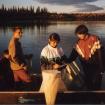Willow
As fuel
The small, dry twigs found among branches on the willow tree are good for starting fires. Mary Francis (COPE,c) said that willow was used to make smoke for drying meat.
As food
In the spring, the Gwich’in peel bark from the new shoots and lick the sweet juice, chew the stem or eat the tips. Annie Norbert said,
Mrs. Norris used to eat the pussy buds just like that.
English



